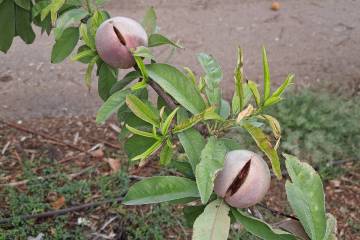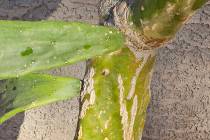Miticides better than insecticides to fight mite problems
Q: My Italian cypress had spider mites, so I sprayed the trees with an insecticide about six weeks ago. Nearby Italian cypress trees are also full of spider mites. I was going to spray them with an insecticide until I listened to your Desert Horticulture podcast, which told me to use a miticide instead. Which one should I use?
A: Spider mites are a hot-weather insect, so spraying now just for them doesn’t make much sense. However, spraying oils in fall and winter months makes perfect sense for insects that might spend the winter on your trees.
Remember, spraying insecticides make mite problems more likely on susceptible plants such as Italian cypress. Miticides, unlike insecticides, are less likely to cause mite problems later. Spider mites are nearly always present on all plants they feed on.
There are lots of insects that feed on spider mites as well and keep them in check. These predatory insects hunt down spider mites and use them for food. Think coyotes and rabbits.
Spraying traditional insecticides like Malathion, Sevin and even organic insecticides like Neem oil or soap and water kills most insects off — good ones as well as the bad one you wanted to control. The primary benefit of an organic spray is its environmental safety and short life after it’s sprayed.
If an insecticide must be sprayed for some reason, watch the sprayed plants very carefully during hot weather to see if spider mites become a problem or not. Frequently spider mites will become a problem after spraying an insecticide because their predators were killed. I realize sometimes it’s necessary, but spray insecticides as a last resort.
Miticides are chosen because spider mites are more like spiders than insects, and sprays that kill insects oftentimes don’t kill spider mites. I am glad you did not use an insecticide for mite control. It would have made the problem worse and probably not killed the spider mites.
Use the University of California Integrated Pest Management websites (“Google” them by using your favorite search engine and typing in “UCIPM” and “spider mites”). Read these notes. They are written by entomologists who specialize in controlling pests. After reading these notes, you will be better informed than 90 percent of the landscapers spraying plants.
The UCIPM notes will recommend spraying oils like canola, clove and cinnamon oils, as well as horticultural oils and sulfur sprays, to control spider mites. In our hot desert environment, these sprays may damage plants during the hot months. It is cool enough in the fall, winter and spring that you can spray oils without damaging most plants. Plants that may be damaged will be listed on the label.
Q: I had a lot of borer damage to my trees, so last summer I cut out most of the large branches and reduced the height of the trees to about 10 feet and let them grow back. Then I treated the soil with an insecticide, surfactant and fertilizer. That was my counterattack regarding the borers.
A: Make sure trees that you do cut back will grow back. Some trees, like most ash trees, will not grow back very well if they are pruned severely. Also, make sure the pruning instruments are all sanitized before pruning.
Insecticides like Imidacloprid (active ingredient) used as a soil drench (mixed with water and contained on the surface of the soil above the roots) are systemic and taken up by roots of the tree and kill many types of borers. Whatever insecticide you use should be systemic and have a label that says it is effective against wood-boring insects.
If the insecticide has staying power inside the tree, then I would apply it after the tree flowers. This is usually in early spring. Long-lasting, systemic insecticides like Imidacloprid are suspected to harm honeybees. There is a possibility the insecticide could be harmful to honeybees if it is applied just before flowering.
I am not sure why you are using a surfactant unless it is to help this insecticide drench move into the soil faster after drenching the area. Surfactants are a very broad category of additives but usually used to move liquid fertilizers, insecticides and fungicides inside plant leaves when they are sprayed.
Q: My Italian cypress trees are getting too tall. Can I top them to keep them smaller?
A: Topping trees is not a good idea, but in this case it will work because underneath all that foliage is a central trunk. It’s not the best way to handle this dilemma, but if it is done when the tree is smaller it will help prevent it from getting too tall. Removing several feet of the top this way is questionable.
Remove the pointed top just below the height wanted. This keeps the tree’s height in check, but it will grow wider than if it were left alone. Hindsight is 20/20. It would have been better to realize these are 40- to 60-foot trees before buying or planting them.
The bad pruning method is shearing the tree with hedge shears. Shearing does prevent long, floppy branches from developing, but it causes other problems. Shearing increases the density of the tree in the outer few inches while the inside branches become naked. The inside of the tree gets darker and darker as shearing increases, and this prevents any greenery from forming.
Eventually, any deep cuts past these 3 or 4 inches outside edge will expose the naked larger branches inside, which have no greenery. None will develop from old wood on Italian cypress, so it won’t grow back. Worse than a bad haircut!
Q: I am purchasing some Italian cypress as a visual barrier between my neighbors and myself. I understand they are evergreen. Any thoughts?
A: Italian cypress is a big tree, so make sure you have room for it and it is in scale with your home and landscape. It can be 40 to 60 feet tall and 4 to 8 feet wide. It is a good visual barrier but tall.
Italian cypress is a Mediterranean plant, not a desert plant. This tree came from climates with cool, wet winters and hot, dry summers, so don’t water too often but more often than true natives. Put it on a valve that waters palms, fruit trees, other landscape trees and shrubs but not with lawns, flower beds or vegetable beds. It will not like it if it is watered with the same frequency as cacti and native desert trees like palo verde and mesquite unless they are watered too often.
Italian cypress with long, drooping branches is a sign it is getting too much water. Either it is watered too often, or the soil is not draining water fast enough. Hedge shearing (not recommended) keeps them in check, but using a hand pruner instead is a better option.
Enough water should be applied each time to wet the soil to at least 2 feet deep. The amount to apply varies because of the soil, so you will have to play around with the number and size of the emitters. But when you apply water, it should wet the area under the canopy out to the ends of the branches. Normally I will tell people wet at least half the area, but these trees are narrow and upright, so water the entire area.
Q: How far apart should I plant my hedge shrubs to make a hedge?
A: It depends on the plant, but a general rule of thumb for shrubs that grow just as wide as they are tall is to plant them the same distance as their mature height. If you plant them this far apart, they will grow up touching each other. If you want them to fill in faster, then plant them a bit closer.
Planting them too close together causes them to grow together, but they will shade each other. That’s not a problem for the hedge, but you will spend more money than you need to in plants.
Bob Morris is a horticulture expert and professor emeritus of UNLV. Visit his blog at xtremehorticulture.blogspot.com. Send questions to Extremehort@aol.com.






























